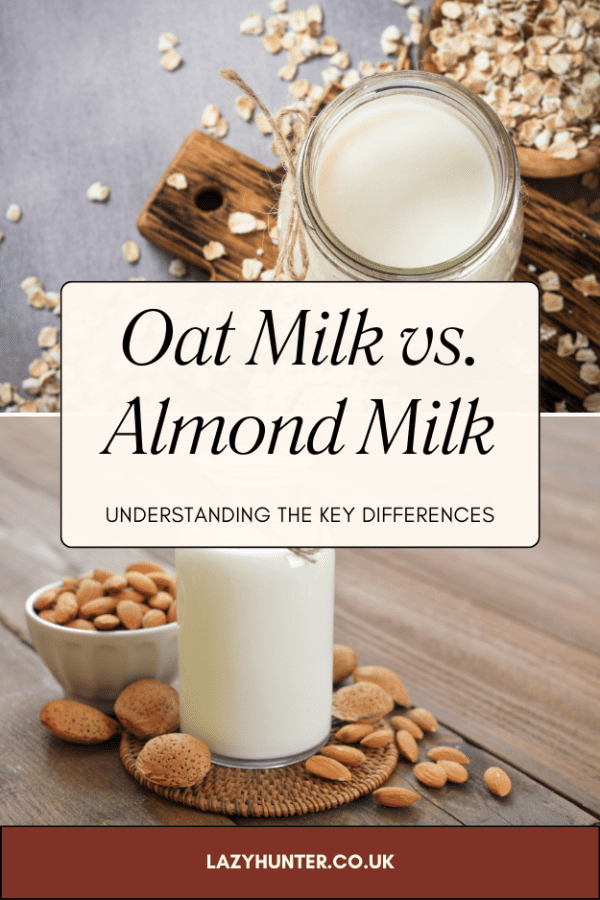Oat milk and almond milk are two popular plant-based milk alternatives that have gained popularity in recent years. While both are known for their unique taste and nutritional benefits, they differ in taste and nutritional content.
Oat milk is creamier and slightly sweeter than almond milk, with more calories, carbohydrates, fibre, and protein. In contrast, almond milk has a nutty and slightly sweet taste, with fewer calories, carbohydrates, protein, and fibre. Understanding these differences can help people decide which milk alternative is best suited to their dietary needs.
Nutritional Comparison
Caloric Content
When it comes to caloric content, both oat milk and almond milk are relatively low in calories compared to traditional cow’s milk. One cup of unsweetened oat milk contains around 120 calories, while the same amount of unsweetened almond milk contains approximately 30-40 calories. However, it is important to note that flavoured and sweetened varieties of both oat milk and almond milk may contain significantly more calories.
Protein Content
In terms of protein content, almond milk generally contains less protein than oat milk. One cup of unsweetened almond milk typically contains around 1 gram of protein, while the same amount of unsweetened oat milk contains around 3-4 grams of protein. However, it is worth noting that neither almond milk nor oat milk are significant sources of protein, and individuals who rely on plant-based milk alternatives for their protein intake may need to supplement their diets with other protein-rich foods.
Vitamins and Minerals
Both oat milk and almond milk can be good sources of certain vitamins and minerals. Oat milk is often fortified with vitamins A, D, and B12, as well as calcium and iron. Almond milk, on the other hand, is often fortified with vitamins A, D, and E, as well as calcium and potassium.
However, it is important to note that the specific nutrient content of plant-based milk alternatives can vary depending on the brand and variety. Additionally, individuals should be aware that some fortified plant-based milk may contain added sugars or other ingredients that may not be beneficial for overall health.
Related
Health Benefits
Heart Health
Both oat milk and almond milk are considered heart-healthy alternatives to dairy milk. Oat milk contains beta-glucans, a type of soluble fibre linked to lower LDL cholesterol levels, also known as the “bad” cholesterol. Almond milk, on the other hand, is low in saturated fat and has been shown to help reduce blood pressure, which can lower the risk of heart disease.
Bone Health
When it comes to bone health, both oat milk and almond milk are fortified with calcium and vitamin D, which are essential nutrients for strong bones. Oat milk typically contains more calcium than almond milk, but almond milk is a good source of magnesium, which is also important for bone health.
Allergies and Sensitivities
For individuals with allergies or sensitivities, oat milk may be a better choice as it is naturally free from lactose, soy, and nuts. Almond milk, on the other hand, is not suitable for those with nut allergies. However, it is worth noting that some individuals may have sensitivities to oats and may need to avoid oat milk as well.
Taste and Culinary Use
Flavor Profile
Oat milk and almond milk have distinct flavour profiles that can affect the taste of dishes and beverages. Oat milk has a mild, slightly sweet flavour that is similar to cow’s milk. It is often described as creamy and nutty, with a subtle oaty taste. On the other hand, almond milk has a nutty and slightly sweet taste that is more pronounced than oat milk. It is thinner in consistency and has a slightly grainy texture.
Cooking and Baking
When it comes to cooking and baking, both oat milk and almond milk can be used as substitutes for cow’s milk. Oat milk is a great option for cream-based soups, sauces, and desserts like custards and puddings. It is also a good choice for savoury dishes like casseroles and pasta sauces. Almond milk is ideal for baking sweet treats like cakes, muffins, and cookies. It can also be used to make creamy sauces and soups.
Beverage Applications
Both oat milk and almond milk can be used in a variety of beverages, including coffee, tea, smoothies, and shakes. Oat milk has a creamy texture that is perfect for lattes and cappuccinos. It blends well with coffee and tea, adding a slightly sweet flavour and a nutty undertone. Almond milk is a popular choice for smoothies and shakes because of its nutty flavour and creamy texture. It is also a great option for those who are lactose intolerant or have a dairy allergy.
Availability and Price
Both oat milk and almond milk are widely available in grocery stores, but the availability may vary depending on the brand and location. Oat milk tends to be slightly more expensive than almond milk due to its more labour-intensive and resource-intensive production process.
On average, a 32-ounce carton of oat milk costs around $3.50 to $4.00, while a 32-ounce carton of almond milk costs around $2.50 to $3.00. However, the price difference is not significant enough for most people to choose one over the other.
Related

